2016 Estonian presidential election
An indirect election took place in Estonia in 2016 to elect the president of Estonia, who is the country's head of state. The Riigikogu — the Parliament of Estonia — elected Kersti Kaljulaid to be the next head of state of Estonia to succeed Toomas Hendrik Ilves, who had served his second and final term as president. (Ilves was term-limited.) Kaljulaid is the first female head of state of Estonia.
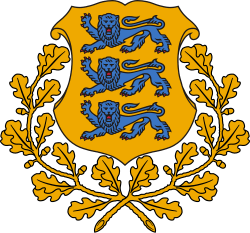 |
|---|
| This article is part of a series on the politics and government of Estonia |
|
Somewhat unusually, Kaljulaid was elected president only after other candidates could not be elected in three rounds of parliamentary voting and two rounds of voting by an electoral college consisting of members of Parliament and representatives of local governments of Estonia.
Process
By law, the president of Estonia is indirectly elected. The Riigikogu (Parliament) has the task of electing the president in the first instance. If no candidate received the required supermajority of two-thirds (68 votes out of 101), the president is selected by an electoral college consisting of MPs and representatives of local (municipal) governments. Failing that, the process is to return to the parliament yet again.[1]
The first three rounds of the election took place in the Riigikogu on 29 August 2016 (first round) and 30 August 2016 (second and third rounds). Since no candidate received the required supermajority in three balloting rounds, an electoral college convened on 24 September consisting of members of Riigikogu and representatives of Estonia’s local governments.[2] The electoral college voted twice, but no candidate managed to reach an absolute majority of 168 votes.[3] Thus, the next round of the election returned to Riigikogu on 3 October.[3] The parliament elected Kersti Kaljulaid, then the country's representative to the European Court of Auditors, as the next President of Estonia.
The incumbent, President Toomas Hendrik Ilves, having served the maximum two terms, was not eligible to run for re-election.
In the Parliament
Candidates
| Candidates | |||
|---|---|---|---|
Allar Jõks IRL and Estonian Free Party Former Chancellor of Justice[4] |
Siim Kallas Reform Party Former Prime Minister and European Commissioner[5] |
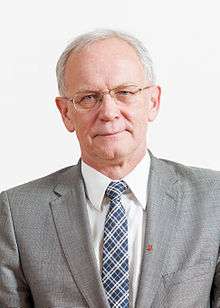 Eiki Nestor Social Democratic Party, Reform Party Speaker of the Riigikogu[6] |
 Mailis Reps Centre Party Member of Parliament, former Minister of Education[7] |
Candidates could be nominated by one-fifth of the members of Riigikogu (21 MPs).[8]
On 30 May 2016, Social Democratic Party endorsed Eiki Nestor as the party’s candidate, but lacked MPs to officially support the bid. Same day the Pro Patria and Res Publica Union's Parliamentary Group endorsed Allar Jõks.[9] On 8 August, Jõks was also endorsed by the Estonian Free Party, after which he had enough backing for official candidacy.[4]
On 11 June 2016, with 53% of the votes the Centre Party elected Mailis Reps as their presidential candidate, in preference to Edgar Savisaar.[7]
On 12 June 2016, the Conservative People's Party of Estonia decided to nominate Mart Helme for president.[10] As none of the other parties supported Helme's candidacy, he was left out of the election. Ambassador and former Minister of Defence Jaak Jõerüüt also prepared to run for president, but did not gain support from any party.[11]
On 3 August 2016, the Reform Party nominated Siim Kallas as the party's official candidate.[7] Marina Kaljurand and Urmas Paet had also announced interest in running, although Kaljurand stated that she was interested in doing so only if the electoral college was convened.[12][13] On 23 August, Reform Party and Social Democratic Party made a pact to support Nestor's nomination and to vote for him in the first round of voting and, if this is unsuccessful, to support Kallas in the second and third rounds.[6]
Election results at the parliament
| Candidate | First round | Second round | Third round | |||||
|---|---|---|---|---|---|---|---|---|
| Votes | % | Votes | % | Votes | % | |||
| Allar Jõks | 25 | 24.75 | 21 | 20.79 | – | – | ||
| Siim Kallas | – | – | 45 | 44.55 | 42 | 41.58 | ||
| Eiki Nestor | 40 | 39.60 | – | – | – | – | ||
| Mailis Reps | 26 | 25.74 | 32 | 31.68 | 26 | 25.74 | ||
| Invalid/blank votes | 8 | 7.92 | 1 | 0.99 | 30 | 29.70 | ||
| Abstentions | 2 | 1.98 | 2 | 1.98 | 3 | 2.97 | ||
| Total | 101 | 100 | 101 | 100 | 101 | 100 | ||
| Source: Vabariigi Valimiskomisjon | ||||||||
In the Electoral College
Candidates
| Candidates | ||||
|---|---|---|---|---|
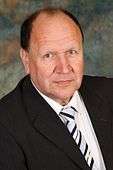 Mart Helme Chairman of EKRE |
Allar Jõks Former Chancellor of Justice |
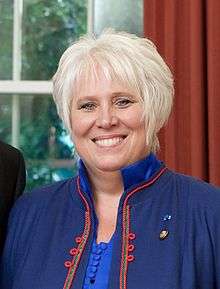 Marina Kaljurand Former Minister of Foreign Affairs |
Siim Kallas Former Prime Minister and European Commissioner |
 Mailis Reps Member of Parliament, former Minister of Education |
After the members of Riigikogu failed to elect the president, the electoral college was called to convene and the nomination procedure started over. Each candidate needed 21 members of the electoral college to nominate them. As Kallas and Reps were in the last voting round in the Riigikogu, they automatically qualified as candidates.[14]
On 30 August 2016, the Reform Party decided to support Siim Kallas in the electoral college, whilst Marina Kaljurand was also interested in running. After the decision, Kaljurand announced that she would step down from her position as Minister of Foreign Affairs and would run for presidency without the support from the Reform Party.[15] Her presidential bid was then supported by the Social Democratic Party.[16]
Both the Free Party and Pro Patria and Res Publica Union decided to keep backing Allar Jõks in the electoral college and gathered enough signatures for nomination.[17]
On 20 September, the chairman of Conservative People's Party of Estonia Mart Helme announced that he had gathered enough signatures for nomination.[18]
Results at the electoral college
| Candidate | Fourth round | Fifth round | |||||
|---|---|---|---|---|---|---|---|
| Votes | % | Votes | % | ||||
| Mart Helme | 16 | 4.78 | – | – | |||
| Allar Jõks | 83 | 24.78 | 134 | 40.00 | |||
| Marina Kaljurand | 75 | 22.39 | – | – | |||
| Siim Kallas | 81 | 24.18 | 138 | 41.19 | |||
| Mailis Reps | 79 | 23.58 | – | – | |||
| Invalid/blank votes | 0 | 0 | 60 | 17.91 | |||
| Abstentions | 1 | 0.30 | 3 | 0.90 | |||
| Total | 335 | 100 | 335 | 100 | |||
| Source: Vabariigi Valimiskomisjon | |||||||
Back to the Parliament
Candidates
| Candidate |
|---|
.jpg) Kersti Kaljulaid Reform Party, Centre Party, Social Democratic Party, IRL, Free Party Estonian representative to the European Court of Auditors |
After the electoral college failed to elect the president, the election returned to the Parliament and the nomination procedure started over. After the results of the electoral college were announced, Jõks stated that he would not run again.[19] Helme also announced that he won't run again and argued that all other previous candidates should do the same, as "new candidates were needed". Later also Kaljurand announced that she wouldn't run again.[20]
On 27 September, a "council of elders" of Riigikogu (consisting of the speaker, vice-speakers, and leaders of all party fractions) met in order to find a common candidate for all parties. They decided to propose Kersti Kaljulaid, the Estonian auditor in the European Court of Auditors.[21] The proposal was received positively by the parliamentary parties, most of the MPs supporting Kaljulaid's election.[22] On 30 September 2016, Kaljulaid was officially nominated by 90 MPs. As there were not enough uncommitted MPs left to nominate another candidate, Kaljulaid was be the sole candidate in the election.[23]
Results
| Candidate | Sixth round | ||
|---|---|---|---|
| Votes | % | ||
| Kersti Kaljulaid | 81 | 80% | |
| Invalid/blank votes | 17 | 17% | |
| Abstentions | 3 | 3% | |
| Total | 101 | 100 | |
| Source: Vabariigi Valimiskomisjon | |||
Opinion polls
Even though the president was not elected by popular vote, there were numerous public opinion polls studying candidates' popularity.[24]
| Poll source | Survey dates |
Sample size |  |
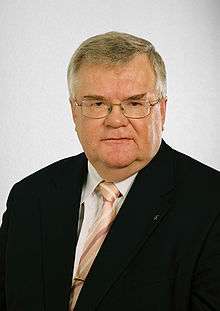 |
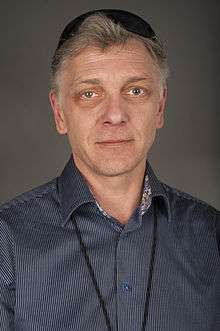 |
 |
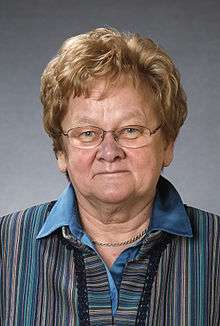 |
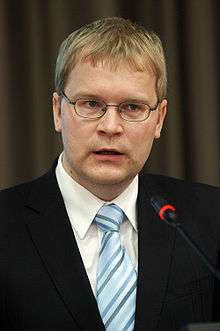 |
 |
 |
 | ||
|---|---|---|---|---|---|---|---|---|---|---|---|---|---|
| Kaljurand Ind. |
Savisaar Kesk |
Tarand Ind. |
Kallas Ref |
Rüütel EKRE |
Ergma IRL |
Paet Ref |
Helme EKRE |
Jõks Ind. |
Nestor SDE |
Reps Kesk | |||
| TNS Emor | Sep 2016 | 1009 | 40% | – | – | 18% | – | – | – | 6% | 5% | 7% | 8% |
| Turu-uuringute AS | Aug 2016 | 1003 | 22% | 15% | 6% | 17% | – | – | 2% | 5% | 8% | 3% | 3% |
| TNS Emor | Aug 2016 | 1505 | 30.4% | – | – | 22.3% | – | – | – | 6% | 6.9% | 4.9% | 7.8% |
| Turu-uuringute AS | Jun 2016 | – | 29% | 14% | 6% | 9% | – | – | 2% | 4% | 8% | 2% | 1% |
| TNS Emor | Jun 2016 | 1375 | 25% | 14% | 6% | 11% | – | – | 4% | 5% | 11% | 2% | 2% |
| TNS Emor | Apr 2016 | 1293 | 30% | 14% | 10% | 12% | – | – | – | 5% | 3% | 2% | – |
| Turu-uuringute AS | Jan 2016 | 1001 | 23% | 14% | 9% | 8% | 5% | 4% | 3% | – | – | 3% | – |
| TNS Emor | Dec 2015 | – | 20.3% | 12.6% | 9.5% | 10.6% | 3.2% | 4% | 2.9% | – | – | 1.4% | – |
| TNS Emor | Aug 2015 | 1203 | 14.3% | 13.2% | 10.1% | 11.2% | 3.4% | 5.4% | 4.8% | – | – | 2.3% | – |
| TNS Emor | Mar 2015 | 1251 | 10.4% | 13% | 9.6% | 13% | 3.6% | 6.7% | – | – | – | 1.3% | – |
References
- Köker, Philipp (2019). "The effects of majority requirements, selectorate composition and uncertainty in indirect presidential elections: the case of Estonia". East European Politics. 35 (2): 238–258. doi:10.1080/21599165.2019.1604339. ISSN 2159-9165.
- "New President to be elected in August or September". ERR. 5 January 2016.
- "Postimehe otsesaade Estoniast: president jäi jälle valimata!" [Postimees live from "Estonia" (the concert house): The President was not elected again!] (in Estonian). Postimees. 24 September 2016.
- "Allar Jõks confirms intention to run for president in the Riigikogu". ERR. 8 August 2016. Retrieved 8 August 2016.
- "Reform Party Board of Directors confirms Siim Kallas as party's presidential candidate". ERR. 3 August 2016. Retrieved 3 August 2016.
- "Reform, SDE to support Nestor for president in first balloting round, Kallas in following rounds". ERR. 23 August 2016. Retrieved 23 August 2016.
- "Keskerakonna presidendikandidaadiks valiti Mailis Reps" [Mailis Reps chosen as the Center Party's presidential candidate] (in Estonian). Postimees. 11 June 2016. Retrieved 11 June 2016.
- "President of the Republic of Estonia Elections". Vabariigi Valimiskomisjon. Retrieved 25 April 2016.
- "Nestor endorsed by SDE, Jõks by IRL board and parliamentary group for president". ERR. 30 May 2016. Retrieved 31 May 2016.
- "Mart Helme confirmed EKRE's presidential candidate". ERR. 13 June 2016. Retrieved 14 June 2016.
- "Jaak Jõerüüt also prepared to run for president". ERR. 23 April 2016. Retrieved 23 April 2016.
- "Kaljurand: Make Kallas the party's candidate in the Riigikogu". ERR. 21 July 2016. Retrieved 20 August 2016.
- "MEP Urmas Paet ready to run for president in Estonia". ERR. 26 April 2016. Retrieved 26 April 2016.
- "Presidential election moves on to electoral college". ERR. 30 August 2016. Retrieved 30 August 2016.
- "Marina Kaljurand steps down as foreign minister, announces presidential candidacy". ERR. 9 September 2016. Retrieved 9 September 2016.
- "Social Democrats back Marina Kaljurand for president". ERR. 20 September 2016. Retrieved 20 September 2016.
- "Presidential nominations: Kallas, Reps, and Jõks safe, Helme 19, others not yet clear". ERR. 16 September 2016. Retrieved 16 September 2016.
- "Mart Helme to submit 21 signatures of support to National Electoral Committee". ERR. 20 September 2016. Retrieved 20 September 2016.
- "Electoral college fails to elect next head of state". ERR. 24 September 2016. Retrieved 24 September 2016.
- "Kaljurand uninterested in nominating herself again". ERR. 27 September 2016. Retrieved 27 September 2016.
- "Parlt party leaders see Kersti Kaljulaid as presidential candidate". Postimees. 27 September 2016. Retrieved 27 September 2016.
- "Kaljulaid has enough support for both nomination and election". ERR. 28 September 2016. Retrieved 28 September 2016.
- "Kaljulaid nominated for president with 90 signatures, no opportunity left for additional candidates". ERR. 30 September 2016. Retrieved 30 September 2016.
- "Poll: Foreign Minister Marina Kaljurand would be most popular presidential candidate". ERR. 8 January 2016.